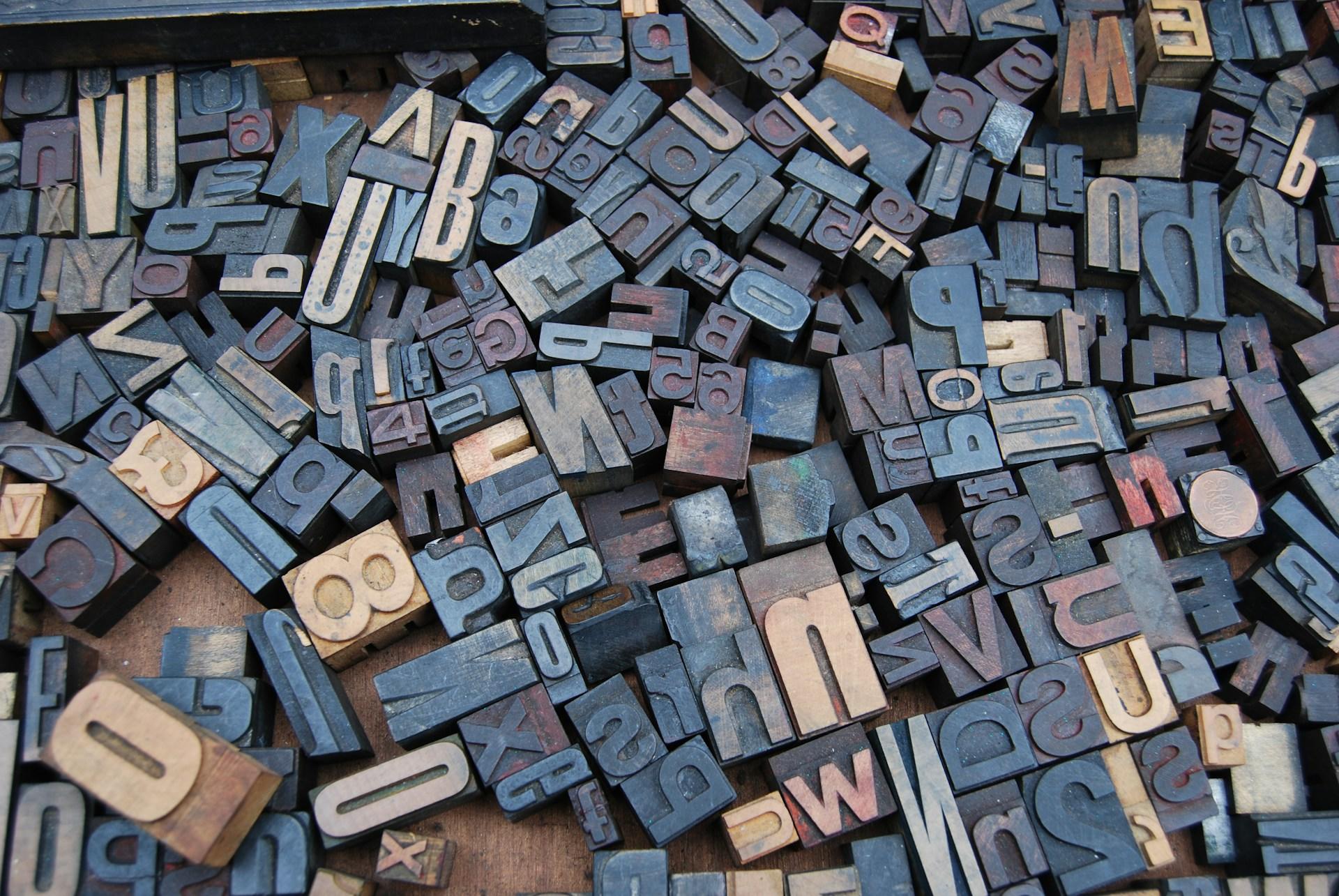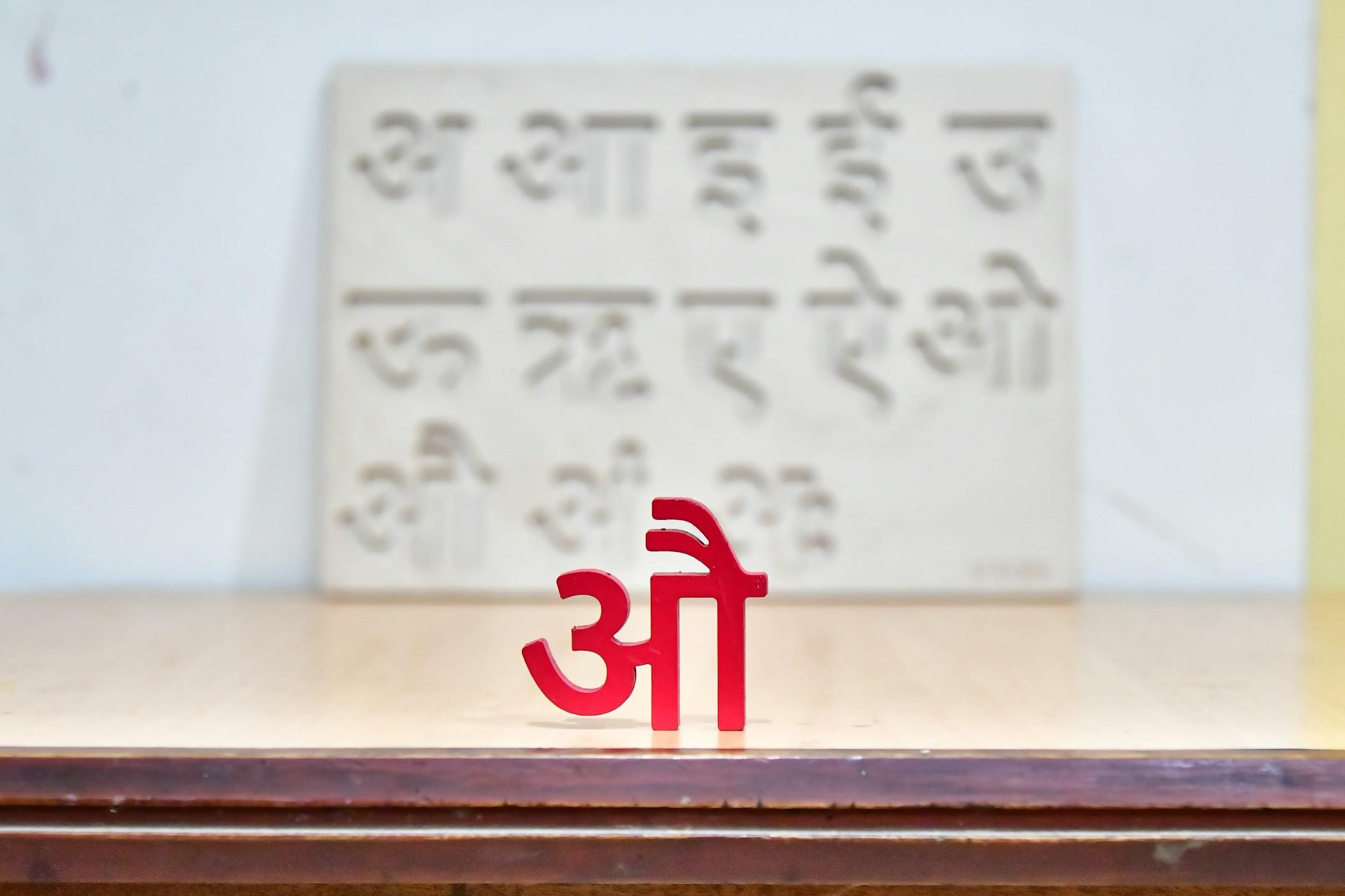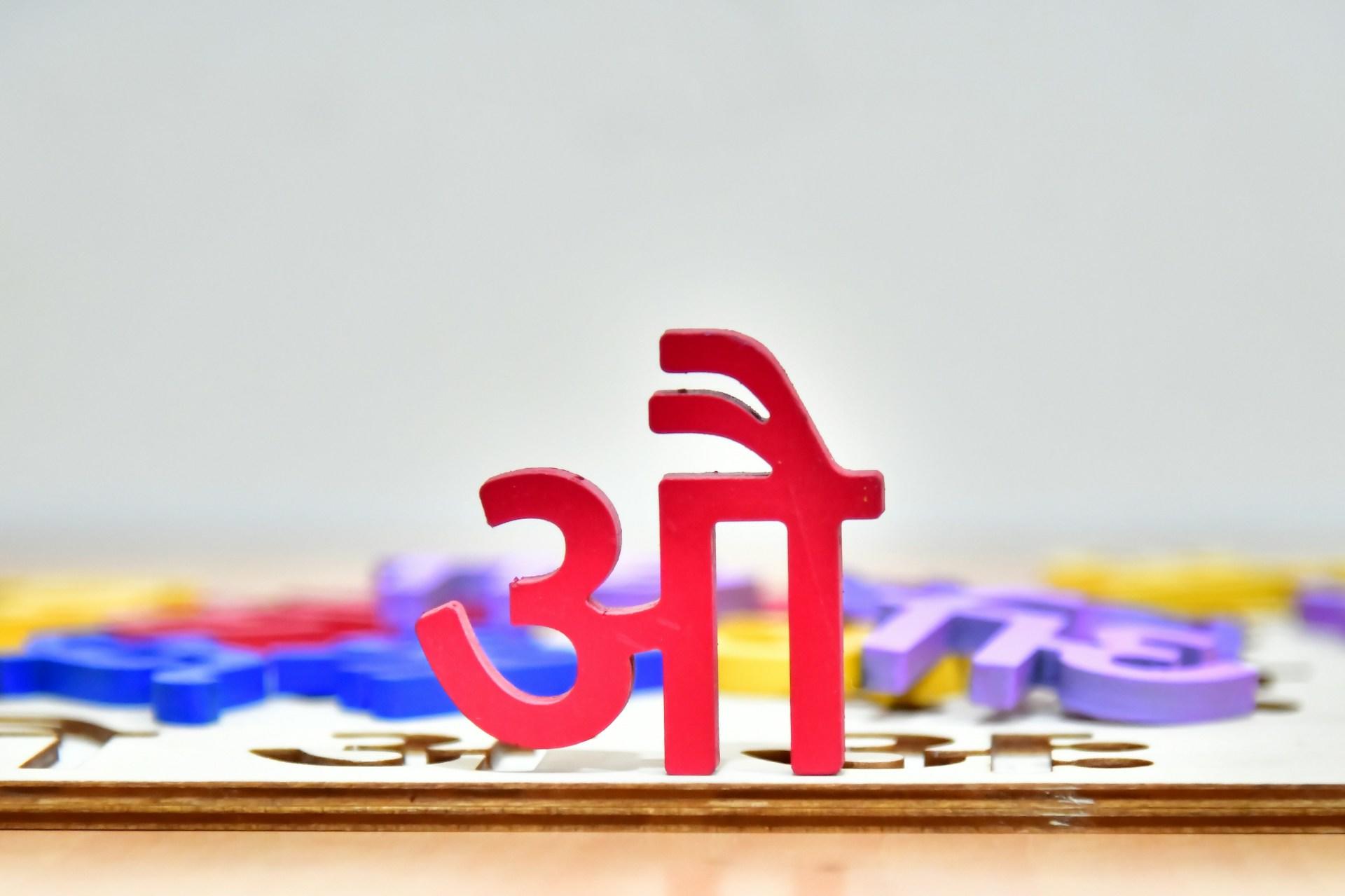Hindi is a challenging but interesting language, but its writing system, the Devanagari Script, makes it quite difficult for native English speakers and anybody who is used to the Latin alphabet. Here's everything you need to know about it and how to learn it.
Key Takeaways
- Hindi is written using the Devanagari script, with each letter corresponding to a specific sound.
- Pronunciation is an essential part of being understood and avoiding confusion between similar-sounding words.
- Hindi uses vowel and consonant pairs, including aspirated and retroflex sounds that English speakers will likely be unfamiliar with.

How Do You Write in Hindi?
Hindi is written using an alphabet called Devanagari. It is only one of many scripts in India.
Many Indian languages have their own script. While Hindi is an official language of India, so are many others. The government of India has issued a list of several dozen recognized languages, many of which have their own writing system.

So, if you decide to learn Punjabi, you could write in either Shahmukhi or Gurmukhi. Gujarati has its own script, as does Telugu, Kannada, Sinhalese (Sinhala), Tamil, Odia. Nepali also has its own alphabet, though it can be written in Devanagari. Though separate scripts, Bengali and Assamese are very similar to Devanagari, derived from Brahmic scripts.
different languages.
History of the Devanagari Script
Before learning how to speak Hindi and mastering the Devanagari Script, it can help to know where the writing system comes from.
The word “Devanagari” comes from the words “Nagari” (older versions of the script go by that name), which means “city,” and “deva,” which means “holy, heavenly.” It is a Brahmic script, a family that includes several Indian scripts and alphabets from Nepal, Tibet, and Southeast Asia.
Brahmic Scripts
The origins of the Brahmic scripts are still debated. Some believe they may derive from Aramaic, others from Phoenician, and others postulate an indigenous origin from this Indic script.
Prakrit texts dating to the 3rd to 1st century BC are the earliest-known examples of a Brahmic inscription. Brahmic scripts were first used to write Sanskrit in the 1st century BC. Examples of Brahmi can be found throughout northern and central India.
The Gupta script
The Gupta Brahmi Script was first attested around the 1st century AD, mostly on iron or stone pillars and coins minted by the Gupta Empire of India. It was further developed into the Nagari, Sharada, and Siddham scripts.
The Nagari Script
By the 7th century AD, Nagari was commonly used to write Prakrit and Sanskrit; by the end of the first millennium AD, it had evolved into Devanagari and Nandinagari (one of the Hindi alphabets used in central and south India, and that has also been used for Sanskrit).
Urdu, the version of Hindi spoken as the official language of Pakistan, is written with a variation on a Persian calligraphy script called Nasta’liq. This script, derived from Arabic, is written from right to left. The letters have a slightly different form depending on whether they are at a word's beginning, middle, or end.
Basics of the Hindi Alphabet
Hindi is an alphabet writing based on the abugida system in which consonants are the main element, with vowel notation being secondary.
While vowels and consonants are equally important in the English alphabet (derived from Latin), the Hindi alphabet writing uses modifications of the consonants to indicate vowel sounds. Calling it an "alphabet" is a bit inaccurate, linguistically speaking, so just remember that the characters in this writing system don't function exactly the same as the letters do in our alphabet.
Hindi transliteration
Transliteration is a means of bringing a language with another writing system into the Latin script.
While an internationally recognized standard for transliterating Sanskrit exists, no true standard exists to approximate how Hindi is pronounced. This is why it is so important to know the Hindi letters when learning Hindi.

Learning the international phonetic alphabet is useful if you can. If you click on one of the symbols on this site, you can hear it spoken, making it easier to learn the consonants and vowels with the right pronunciation.
The Hindi Vowels
Each of the Hindi vowels exists as a standalone letter. However, they are only used to write Hindi words if the vowel:
There is generally a long and a short version of each vowel - a difference that becomes important once you start pronouncing Hindi. The long versions typically take the symbols for the shorter version but add on to it with one or more extra strokes.
Here are the vowels in their independent form (in the Chandas font):
| Hindi Vowel | English Equivalent | Pronunciation Hint |
|---|---|---|
| अ | a | Like 'a' in "about" |
| आ | ā | Like 'a' in "father" |
| इ | i | Like 'i' in "bit" |
| ई | ī | Like 'ee' in "see" |
| उ | u | Like 'u' in "put" |
| ऊ | ū | Like 'oo' in "food" |
| ऋ | ṛ | A sound between 'r' and 'ri' |
| ए | e | Like 'e' in "they" |
| ऐ | ai | Like 'ai' in "aisle" |
| ओ | o | Like 'o' in "go" |
| औ | au | Like 'ow' in "cow" |
| अं | ṃ or ṁ | Nasalized 'm' |
| अः | ḥ | Like a soft exhalation or 'h' sound |
The Hindi Consonants
In its independent form, each Hindi consonant automatically comes with the short version of the vowel “a” attached to it. Here is a list of Hindi consonants:
Velar Consonants (क वर्ग)
| Hindi Consonant | English Equivalent | Pronunciation Hint |
|---|---|---|
| क | k | Like 'k' in "kite" |
| ख | kh | Like 'k' in "kite" with an extra puff of air (aspirated) |
| ग | g | Like 'g' in "go" |
| घ | gh | Like 'g' in "go" with an extra puff of air |
| ङ | ṅ | Like 'ng' in "sing" |
Palatal Consonants (च वर्ग)
| Hindi Consonant | English Equivalent | Pronunciation Hint |
|---|---|---|
| च | c | Like 'ch' in "church" |
| छ | ch | Like 'ch' in "church" with aspiration |
| ज | j | Like 'j' in "judge" |
| झ | jh | Like 'j' in "judge" with aspiration |
| ञ | ñ | Like 'ny' in "canyon" |
Retroflex Consonants (ट वर्ग)
| Hindi Consonant | English Equivalent | Pronunciation Hint |
|---|---|---|
| ट | ṭ | Like 't' in "stop" (retroflex, tongue curled back) |
| ठ | ṭh | Like 't' in "stop" with aspiration (retroflex) |
| ड | ḍ | Like 'd' in "dog" (retroflex) |
| ढ | ḍh | Like 'd' in "dog" with aspiration (retroflex) |
| ण | ṇ | Like 'n' in "none" (retroflex) |
Dental Consonants (त वर्ग)
| Hindi Consonant | English Equivalent | Pronunciation Hint |
|---|---|---|
| त | t | Like 't' in "tap" (dental, tongue against teeth) |
| थ | th | Like 't' in "tap" with aspiration |
| द | d | Like 'd' in "dog" (dental) |
| ध | dh | Like 'd' in "dog" with aspiration |
| न | n | Like 'n' in "no" |
Labial Consonants (प वर्ग)
| Hindi Consonant | English Equivalent | Pronunciation Hint |
|---|---|---|
| प | p | Like 'p' in "pen" |
| फ | ph | Like 'ph' in "phone" (aspirated) |
| ब | b | Like 'b' in "bat" |
| भ | bh | Like 'b' in "bat" with aspiration |
| म | m | Like 'm' in "man" |
Semivowels (अन्तःस्थ व्यंजन)
| Hindi Consonant | English Equivalent | Pronunciation Hint |
|---|---|---|
| य | y | Like 'y' in "yes" |
| र | r | Like 'r' in "run" |
| ल | l | Like 'l' in "love" |
| व | v | Like 'v' in "vine" or 'w' in "water" |
Sibilants and Aspirates (उष्म व्यंजन)
| Hindi Consonant | English Equivalent | Pronunciation Hint |
|---|---|---|
| श | ś | Like 'sh' in "shy" |
| ष | ṣ | Like 'sh' in "shy" (retroflex) |
| स | s | Like 's' in "see" |
| ह | h | Like 'h' in "house" |
Special Consonants
| Hindi Consonant | English Equivalent | Pronunciation Hint |
|---|---|---|
| ळ | ḷ | Retroflex lateral sound (found in Marathi more commonly) |
| क्ष | kṣ | Combination of 'k' and 'sh' sounds |
| त्र | tr | Combination of 't' and 'r' sounds |
| ज्ञ | jñ | Combination of 'j' and 'ñ' sounds |
Are you more of a visual learner? Here's a good video to learn the consonants.
The Top Line
A characteristic of Hindi writing is the horizontal line along the top of the words. When writing by hand, it is often left out or written last, but it’s always present in print form. When writing down your Hindi vocabulary in your notebook or flashcards, you should try and include it so you can recognize the words better when you see them printed in a sentence.
Ligatures
Specific consonant clusters that appear often are grouped into ligatures - think of how English has æ as a ligature of a and e in certain words. The vowels between these consonants are often suppressed so that only the consonants appear in the ligature.
Learning to Write the Hindi Letters
It’s not always easy to learn a new script. Remember when you first had to learn the Latin alphabet?
Fortunately, your coordination will have improved since then and you won't have to relearn how to hold a pen or pencil! Still, your brain will need to get used to forming these new characters, but it will take a little while before each letter is perfect.

Wikipedia Commons has an excellent series of gifs to teach you the stroke order for making Hindi letters as a bit of animation. Why not take a page from your early school days to practice writing Devanagari? Get a lined notebook of the kind children use to practice the alphabet or learn calligraphy. Then repeat each letter for several lines - first alone, and then with its diacritic marks.
The more you practice, the better your Hindi handwriting will be!
While these tips are helpful for writing the script, why not use Bollywood movies to learn Hindi and have fun simultaneously?

Resources to Help You Practice Writing in Hindi
Every learner is different. The key to effectively learning any skill, including writing using the Devanagari Script, is to find the resources that work for you.
Here, we've put together a few that you may want to take a look at.
Live Lingua
We have discovered a great free online learning resource called Live Lingua (a language school). Its creators believe that everybody should be able to learn another language no matter their age, financial situation, or background. Hence, they have made the Free US Peace Corps Hindi resources available for anyone to use and to take away some great language lessons.
With this amazing resource, you can tackle learning Hindi from two perspectives: listening and reading. Listening and reading will, in turn, help you with your writing and letter-forming.
With this, you can read Hindi ebooks online. Moreover, you don't need an Internet connection to take advantage of this. You can download the files to your PC or device whenever you want. Therefore, this doubles up as an online/offline resource!
Translate Apps
We shouldn't underestimate the power of a simple dictionary or translation app to help us learn basic Hindi phrases and what words look like to the naked eye. This could open your eyes to the connection between letters, their pairing, and the sounds made, especially if you use it alongside an audio resource.
You could listen to a Hindi radio station and then look up certain words you hear to look at the full word in writing. (For this, you'll likely need a Hindi font installed, too; more on this below.)
If you can't find the word because you can't figure out how it is spelled, try using voice detection tools like Siri or an app. If you have one, it will detect and display the word on your screen!
Writing Activities to Practice What You've Learned
While reading and trying to remember the characters of the Devanagari script are one way to learn, it's strongly recommended that you learn by doing. There are lots of ways to reinforce your studying, but these are some of the activities that we find to be the most effective. Just remember that no two learners are alike; focus on the activities from which you get the best results!
Writing Worksheets
If you want to focus on just writing Hindi, though, and feel more confident at recognizing Hindi script and want to try your hand at writing it yourself, you can find a range of downloadable resources such as worksheets. By looking on Google, you can find some fantastic materials at Study Village focused on writing practice. Twinkl is also a fantastic resource for Hindi learners, with some fabulous printable exercise sheets that are on offer for free. However, if you want to learn to have a Hindi conversation, you should probably work with a teacher, tutor, or language exchange partner.
What's more, you can purchase paperback workbooks with similar exercises from Amazon.
Hindi on Your Electronic Devices
If you want to write Hindi on your electronic devices, you must install a Hindi font. Unfortunately, none of the available fonts supports all the common ligatures, which is unfortunate when trying to learn Hindi and apply the finer points of the Hindi writing system.
Hindi Fonts for Your Computer
Many computer Devanagari fonts try to imitate Hindi calligraphy and can be rather beautiful. Some sites offer a list of Hindi fonts grouped into several categories, including professional, handwriting, and decorative. Pick one you like and download it!
Try to find a True Type (the icon will have TT on it) or Unicode font to ensure that it appears the way it does on the screen when you print.
Hindi Fonts for Your Smartphone
Most smartphone operating systems come with a Hindi keyboard (some even support other Indian alphabets). To change the keyboard setting, go to your system settings.
However, this is only practical if you only want to type in Hindi. Switching between Hindi and English regularly gets annoying. This is why many Hindi people prefer transliteration when writing on social media such as WhatsApp and Twitter. However, in 2016, Google released the Indic Keyboard for Android devices, which allows you to switch easily between various Indian alphabets and English. On iPhones, you can add a new keyboard and switch by pressing the “globe” icon on your current keyboard.

Do You Need to Get a Hindi Keyboard?
To write the Devanagari script, you can change the keyboard options on your computer and type using your normal keyboard. Here is the usual layout (called InScript) on a standard QWERTY keyboard. However, if you don’t want to learn the layout by heart, you might want to invest in an InScript keyboard for when you have to do a lot of typing in Hindi.
Learn Hindi and the Devanagari Script with a Private Tutor
Practice certainly makes perfect when learning a language or a new writing system, and private tutoring offers some of the best ways to practice regularly.
On the Superprof website, plenty of talented and experienced private tutors can help you learn Hindi and the Devanagari Script. With face-to-face tutors all over the country and online tutors from around the world, you can find someone no matter where you live.
Most of the tutors on Superprof offer the first session for free, allowing you to try potential tutors before choosing the right one. After all, what works for one student doesn't necessarily work for another.
To start mastering Devanagari Script, search for "Hindi" on the Superprof website today!















